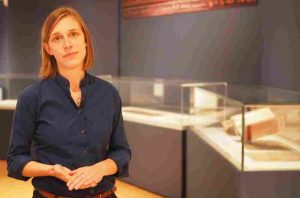OXFORD – Like many, for years, I had assumed that the drawings and sculptures that we have attached to the identities of religion have been similar throughout the ages.
Imagine then my surprise to discover that the historical personality Jesus had been depicted first as a beardless figurine, then later as a bearded one.
Or that for three hundred years, that’s at least twelve generations, all of the imagery around Buddha was simply of a footprint with no full-bodied statues as we see today.
These and many more fascinating tidbits of information are not just learned but visually demonstrated, as religious artifacts from five of the world’s leading faiths are brought together and put on display at the Ashmolean Museum in Oxford.
The exhibition looks at the history of art in the religions of Islam, Christianity, Judaism, Hinduism, and Buddhism. It shows how what people have come to assume about religious objects and identities change over time.
Co-curator, Jas Elsner outlined the exhibition as showing “the beginning of the visual identities of what we know now as the world religions, Christianity, Judaism, Islam, Buddhism, and Hinduism.”
“When they came together, when they acquired those identities, in the period that we know as the late antiquity, roughly the first millennium after Christ,” he added.
“The Arabs assimilated and controlled hugely different cultures, with a vast range of visual identities. And in early Islam, what we see is a way of assimilating those identities, and playing with them, until finally, in contradiction to the Christians on the west who use flat icons of Christ and the saints, against the Hindus and the Buddhists in the east, who use three dimensional statues, Islam developed a fondness, a predilection, for non-figural imagery, scriptural imagery, around the Qur’an.”
Influence of Muslim Women
Co-curator Stefanie Lenk spoke about their collection of beautiful pages from the Qur’an going back all the way to the earliest Qur’anic manuscripts which use the original Hijazi script.
“Early Islamic artists developed an Islamic artistic language on their own. And they focused very much on the holy text of the Qur’an, making the text itself very beautiful… And at the end there is one of my favorite objects from the exhibition actually, the nurses Qur’an,” Lenk told AboutIslam.
“Or rather a folio of the nurse’s Qur’an which was this huge manuscript, many many volumes, maybe 30 volumes because there are only five lines on each page, so maybe it was used to show it around, to show it to the congregation. The nurse’s Qur’an has its name from a nurse, in fact, the nurse who gave this Qur’an, the nurse of a Zirid prince, in Kairouan, Tunisia, who gave this Qur’an to the mosque.”
“I like this because for many of these fantastic manuscripts we do not really have an idea who made it the Qur’ans or who donated them, but for this one we do, and it is, in fact, a woman. And so it is a story that would be lost if it was not for the coincidence of this manuscript having survived.”
“It tells us a lot about early Muslim society function, that it was perfectly normal for a woman to have the means and the social standing, to give a Qur’an to a mosque,” she added.
One of the most fascinating pieces on display is the Ballycottin brooch. Dating from the 8th or 9th century, it was made in Western Europe, found in Ireland, and in the heart of the cross is a glass seal either from Syria or Iran with an Arabic inscription reading ‘If God wills.’ Was this simply something pretty or did it signify something more significant, that followers of different faiths can and should get along well with each other? This is open to interpretation.
Summing up the exhibition Jas Elsner said, “The exhibition attempts to see religion through the orbit of visual and material culture as much as through text.”
“We think of religion as often as scriptural, but for their adherents, they are devotion, they are about objects, they are about spaces where objects define the quality of experience. And so we’ve been looking at that aspect primary in this project.”
Imagining The Divine: Art and the Rise of World Religions runs from 19 October 2017 to 18 February 2018.



